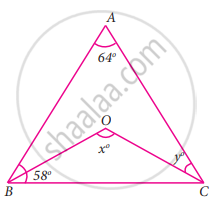Advertisements
Advertisements
प्रश्न
In a quadrilateral ABCD, ∠A + ∠C is 2 times ∠B + ∠D. If ∠A = 140° and ∠D = 60°, then ∠B=
पर्याय
60°
80°
120°
80°
None of these
उत्तर
ABCD is a quadrilateral, with ∠A +∠C = 2(∠B + ∠D) .
By angle sum property of a quadrilateral we get:
∠A +∠B +∠C +∠D = 360°
(∠A +∠C )+(∠B +∠D) = 360°
But,we have ∠A+∠C = 2(∠B +∠D)
2(∠A + ∠C = 360°
∠A + ∠C = 120°
Then,
∠B + ∠D = 60°
The two equations so formed cannot give us the value for ∠B with a given value of ∠A .
Hence the correct choice is (d).
APPEARS IN
संबंधित प्रश्न
In a parallelogram ABCD, determine the sum of angles ∠C and ∠D .
In a parallelogram ABCD, if `∠`B = 135°, determine the measures of its other angles .
The sides AB and CD of a parallelogram ABCD are bisected at E and F. Prove that EBFD is a parallelogram.
P and Q are the points of trisection of the diagonal BD of a parallelogram AB Prove that CQ is parallel to AP. Prove also that AC bisects PQ.
In a ΔABC median AD is produced to X such that AD = DX. Prove that ABXC is a
parallelogram.
In a parallelogram ABCD, if ∠D = 115°, then write the measure of ∠A.
In a parallelogram ABCD, if ∠A = (3x − 20)°, ∠B = (y + 15)°, ∠C = (x + 40)°, then find the values of xand y.
The figure formed by joining the mid-points of the adjacent sides of a parallelogram is a
P is the mid-point of side BC of a parallelogram ABCD such that ∠BAP = ∠DAP. If AD = 10 cm, then CD =
In the given figure, ∠A = 64°, ∠ABC = 58°. If BO and CO are the bisectors of ∠ABC and ∠ACB respectively of ΔABC, find x° and y°
